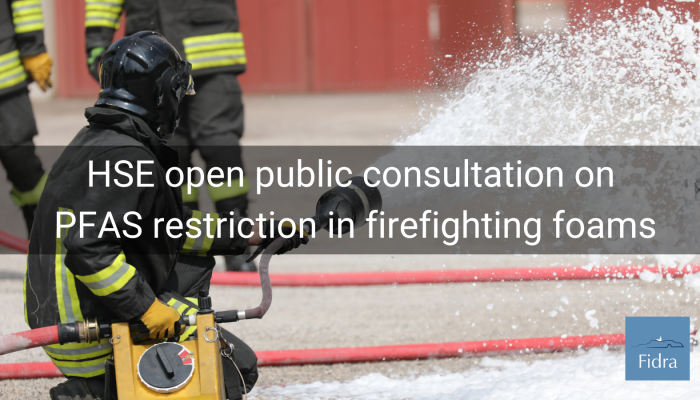
This week, the UK has released its public consultation on restricting PFAS in firefighting foams. The proposal presents a step in the right direction but must form part of broader commitments to transition the UK towards a PFAS-free economy.
The Health and Safety Executive (HSE), as the Agency for UK REACH, who are responsible for assessing and restricting chemicals in the UK has released a ‘dossier’ document outlining a proposed restriction of PFAS in firefighting foams (FFFs)[1]. This is now open to public consultation for 6 months, until 18th February 2026. Comments on the restriction are welcome from anyone, including NGOs, researchers, industry representatives and the public.
A proposed group-based approach to restricting PFAS
Fidra are pleased to see the proposal adopt the broad, internationally recognised OECD definition for PFAS. The dossier suggests restricting the sale and use of PFAS in firefighting foam, where PFAS are defined as “any substance that contains at least one fully fluorinated methyl (CF3) or methylene (CF2) carbon atom without any hydrogen, chlorine, bromine, or iodine atom attached to it.”
The report dossier also acknowledges that it is important to address PFAS as a group to stop the cycle of ‘regrettable substitution’, where one harmful chemical is replaced by another structurally similar chemical with similar potential for harm.
If the restriction is adopted, when would it come into effect?
The proposal will be open for public consultation for 6 months. Responses will then be reviewed and a decision will be made as to whether the restriction is adopted and if any amendments are required. Should the current proposal be adopted, there will be specified transitionary periods for different sectors to phase out the use and sale of PFAS in their products. These transitional periods vary from 6 months to 10 years, with the longer transitional periods being assigned to use of PFAS FFFs in offshore oil and gas installations, and for Control of Major Accident Hazards (COMAH). It is estimated that the majority of PFAS containing FFFs on the market in the UK are used by the petrochemical industry (this sector makes up approximately 60% of the total sales volume)[1]. Most other uses of PFAS FFFs are proposed to be phased out in no more than 5 years.
PFAS contamination from firefighting foams in the UK
This restriction is urgently needed as FFFs has long been a significant source of environmental PFAS contamination. According to the HSE dossier, firefighting foams release an estimated 48 tonnes of PFAS into the UK environment every year1.
Research indicates that these foams may be among the top contributors to PFAS contamination in soil[2], severely harming soil health and fertility. PFAS can disrupt soil microbial communities[3], reducing biodiversity and essential connectivity among soil bacteria[4].
Once in the environment, PFAS spread rapidly and can accumulate in groundwater, plants, and animals. Uptake of PFAS has been detected in fruits, vegetables, flowers, grain and crops[5]. This uptake by plants and subsequent transfer through food chains pose a significant concern for human health. Some PFAS have been connected with health impacts including, cancer[6], immune system disorders[7] and fertility issues[8] in humans.
The proposal also comes in the wake of significant groundwater PFAS contamination being uncovered near a firefighting foam testing facility in Bentham, Noth Yorkshire. Recordings demonstrated PFAS concentrations of 1,199,000 ng/l which is thought to be the highest concentration of PFAS ever recorded in the UK[9]. This overwhelming evidence supports adopting the proposed restriction of PFAS in firefighting foams as part of wider efforts to move towards a PFAS-free economy in the UK.
What more can the UK do to tackle PFAS?
While this restriction proposal represents good progress, it is important to recognise it addresses just one source of PFAS pollution. PFAS continue to be used in countless other products and uses, from cosmetics and food packaging, to textiles and pesticides. Sector-specific restrictions alone are therefore not enough to tackle the issue. For example, France’s recently announced restriction on PFAS in cosmetics would only reduce total PFAS emissions by 20%[10]. This highlights why sector-specific restrictions, while valuable, must form part of a broader strategy to move towards a PFAS-free economy.
Fidra, alongside other NGOs and academics, are urging UK Government to commit to a group-based PFAS restriction by aligning with EU chemical regulation, including their proposed universal PFAS restriction. A group-based approach, in line with the proposed FFF restriction, would prevent on-going cycles of regrettable substitution and provide the most robust protection for our health and natural resources.
Further information:
- More information on the FFF restriction proposal can be found on HSE’s website: https://consultations.hse.gov.uk/crd-reach/pfas-in-firefighting-foam-fff-restriction-proposal/
- Our NGO proposal for regulating PFAS in the UK can be found here: https://www.fidra.org.uk/download/regulating-pfas-forever-chemicals-in-the-uk-a-way-forward/
References:
[1] The Health and Safety Executive (HSE), PFAS in firefighting foam (FFF) restriction proposal. [Online], accessed August 2025: https://consultations.hse.gov.uk/crd-reach/pfas-in-firefighting-foam-fff-restriction-proposal/
[2] M Nl Ehsan, M Riza, M N Pervez, C-W Li, A A. Zorpas, V Naddeo. 2024. PFAS contamination in soil and sediment: Contribution of sources and environmental impacts on soil biota, Case Studies in Chemical and Environmental Engineering, Vol 9, https://doi.org/10.1016/j.cscee.2024.100643
[3] Wu, J., Ding, F., Shen, Z., Hua, Z. and Gu, L. 2022. ‘Linking microbiomes with per- and poly- fluoroalkyl substances (PFASs) in soil ecosystems: Microbial community assembly, stability, and trophic phylosymbiosis’ . pp. 135403. , s.l. : Chemosphere, Vol. 305.
[4] Cao, L., Xu, W., Wan, Z., Li, G. and Zhang, F. 2022. Occurrence of pfas and its effect on soil bacteria at a fire-training area using PFOS-restricted aqueous film-forming foams. 4, s.l. : iScience, Vol. 25. p. 104084.
[5] Z Liu, Y Lu, X Song, K Jones, A. J. Sweetman, A. C. Johnson, M Zhang, X Lu, C Su, 2019, ‘Multiple crop bioaccumulation and human exposure of perfluoroalkyl substances around a mega fluorochemical industrial park, China: Implication for planting optimization and food safety’, Environment International, Volume 127, Pages 671-684, ISSN 0160-4120.
[6] M. V Gerwen et al, 2023, Per- and polyfluoroalkyl substances (PFAS) exposure and thyroid cancer risk. eBioMedicine. 97: 104831, https://doi.org/10.1016/j.ebiom.2023.104831
[7] Drake W. Phelps, Ashley M. Connors, Giuliano Ferrero, Jamie C. DeWitt & Jeffrey A. Yoder. 2024. Per- and polyfluoroalkyl substances alter innate immune function: evidence and data gaps, Journal of Immunotoxicology, 21:1, 2343362, DOI:10.1080/1547691X.2024.2343362
[8] L Pang et al, 2024, Association between prenatal perfluorinated compounds exposure and risk of pregnancy complications: A meta-analysis. cotoxicol Environ Saf. DOI: 10.1016/j.ecoenv.2024.116017
[9] Pippa Neill and Tess Colley, ENDS Report, 2024. [Online], accessed August 2025: https://www.endsreport.com/article/1873849/gods-own-dark-waters-exposing-yorkshire-town-became-pfas-polluted-place-uk-regulator-let-happen
[10] Chemsec, ‘Why the French PFAS ban isn’t the victory it seems’. [Online]. Accessed August 2025: https://chemsec.org/why-the-french-pfas-ban-isnt-the-victory-it-seems/
